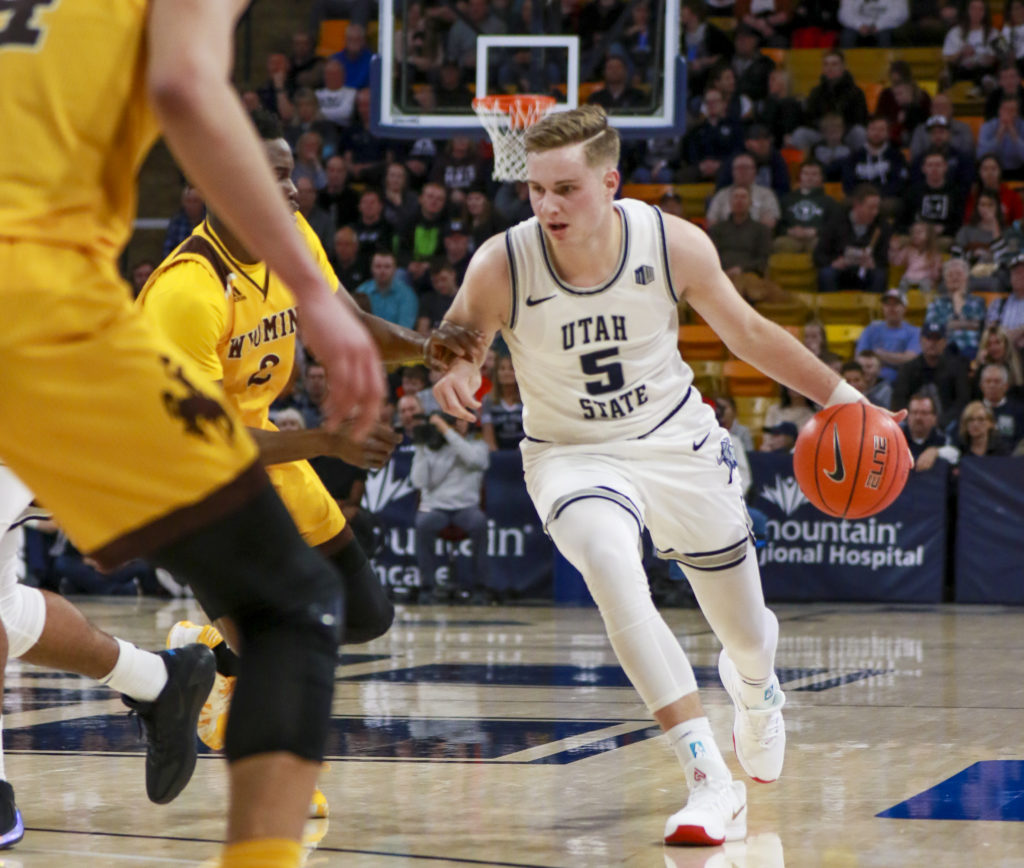
LAS VEGAS – Life as an NCAA tournament bubble team is difficult. But there is salvation for every team hoping to ensure their spot in the big dance: the conference tournament. Three or four games in early March can alleviate all the ails of bubble-hood. The opportunity to remove the chance element, to switch from merely hoping for inclusion to dreaming of another deep tourney run.
That is the opportunity that faces Utah State in the coming days in Las Vegas. Five months ago, Aggie fans couldn’t fathom the season would rely on these next three days. Fans five weeks ago were hoping almost beyond hope that it could. Unanimous preseason picks to win the conference do not typically require a run in the conference tournament to extend their season, but such is USU’s fate this year. Another MW title, while certainly welcomed by fans, might not be entirely required for Utah State to reach the NCAA tournament. At 23-8, the Aggies are squarely on the cusp of the NCAA tournament, almost equally likely to be named to the 68-team field or left out altogether. According to ESPN bracketologist Joe Lunardi, the Aggies are currently the first team left out of the tournament field.
A few wins in Vegas could change that, however, even without am automatic bid via a conference title. Were the Aggies to reach the MW final, USU could find themselves safe within the 68-team field even before the championship game. Last week’s events have cast doubt on USU’s ability to deliver on that chance. Riding a six-game winning streak into the final game of the regular season, the Aggies fell on the road to New Mexico despite carrying a double-digit lead in the second half. With the egregious loss, Utah State dropped from a precarious-yet-relative-safe spot in most projected brackets to its current predicament. In a small twist of irony, Utah State will likely kick off their title defense in a rematch with the Lobos. The Aggies will face the winner between #7 New Mexico and #10 San Jose State on Thursday.
The 3-point line could be the key to Utah State’s tournament hopes in Sin City. Versus New Mexico, the Aggies appeared safe with a 14-point lead before three consecutive Lobo 3s quickly vaporized USU’s cushion and forced the Aggies into a tightly contested game on the road. On the entire season, the arc has existed as more foe than friend to Utah State. During MW play, the Aggies ranked 10th our of the 11 teams in conference in 3-point shooting at only 31 percent from distance. Meanwhile, opponents have shot 32.1 percent from 3, good for fourth-best in the conference but still leaving USU at a negative differential from outside.
Improving that 3-point efficiency is easier said than done. Utah State’s outside shooting frequently relies on the playmaking efforts of senior Sam Merrill. As one of USU’s few options who can generate their own shot, Merrill is already integral to the Aggies’ offense. Merrill’s ability to set up the rest of the offense is just as crucial. Utah State is 13-1 this season when Merrill records four assists or more, and only 8-7 when he’s held to three or fewer, with the only loss coming at San Diego State, where the Aggies held a double-digit lead in the second half on the strength of Merrill’s career-high 12 assists before succumbing to the Aztecs.
But assists are like tangos: they take two. It has been the sad observance of Aggie fans this season to see the 3-point percentages of several of last year’s deep-shot specialists drop precipitously. The trio of Abel Porter, Brock Miller and Diogo Brito each shot over 35 percent from behind the arc last season. This year, however, none of the three have managed to shoot over 30.6 percent from deep. The lack of shooting has effectively suffocated Utah State’s offense at times. Without the spacing provided by non-Merrill players, the driving lanes for Merrill are more easily closed off and the space for Neemias Queta to work in the low post is often mitigated with double teams.
When USU earned that spacing last season, the Aggies were nearly impossible to corral offensively. That offensive firepower, coupled with USU’s usual defensive intensity, resulted in one of Utah State’s best seasons in recent memory. That formula still exists and has been on display in spurts this season. In the aforementioned contest at SDSU, the Aggies blitzed the Aztecs in the first half, shooting 7-9 from 3-point territory (Merrill scored or assisted on five of the seven made 3s) en route to a 39-31 halftime lead. In Utah State’s 94-56 evisceration of San Jose State, only eight days ago, the Aggies shot 10-21 from deep. That included a 6-11 mark from non-Merrill shooters. With the extra space, Queta and fellow low-post bruiser Justin Bean freely patrolled the interior, combining for 35 points and 23 rebounds versus the Spartans.
It’s a simple equation: better 3-point shooting leads to more space for an offense to operate under which leads to easier and better interior play. That is the offensive equation Utah State mathematically dominated en route to the team’s first MW title last season. It is the same equation the team must follow again this season. The talent is there and already proven capable. And for Utah State to reach the heights that seemed almost a certainty before the season bean, they might need to prove it again.

